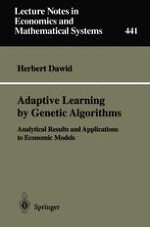1996 | OriginalPaper | Buchkapitel
Genetic Algorithms
verfasst von : Dr. Herbert Dawid
Erschienen in: Adaptive Learning by Genetic Algorithms
Verlag: Springer Berlin Heidelberg
Enthalten in: Professional Book Archive
Aktivieren Sie unsere intelligente Suche, um passende Fachinhalte oder Patente zu finden.
Wählen Sie Textabschnitte aus um mit Künstlicher Intelligenz passenden Patente zu finden. powered by
Markieren Sie Textabschnitte, um KI-gestützt weitere passende Inhalte zu finden. powered by
In the rest of this monograph we will deal exclusively with a special technique from the field of computational intelligence research, namely genetic algorithms. Genetic algorithms were developed by Holland [60] in 1975 as a tool to find solutions of optimization problems in poorly understood large spaces. They are based on the genetic processes of biological organisms, especially on the principle of natural selection that has become famous as “survival of the fittest” since the publishing of The Origin of Species by Charles Darwin [29]. Although, this slogan seems to be slightly tautological in the natural environment, where fitness is defined as the ability to survive, it makes good sense in the world of optimization problems, where the fitness of a string is given as the value of the function to be optimized at the argument encoded by the string. GAs proved to be quite successful in finding good solutions to such complex problems as the travelling salesman problem, the knapsack problem, large scheduling problems, graph partitioning problems, but also for engineering problems like the design of bridge structures or the optimal use of power plants. The most famous application is perhaps one of the first large applications done by Goldberg. By using classifier systems based on GAs he was able to generate a control system that managed the flow in the large gas pipeline from Texas to Chicago (Goldberg [48]). In 1989 Goldberg wrote a seminal book dealing with genetic algorithms, that is up to now probably the most widely spread book in this field of research (Goldberg [50]).
